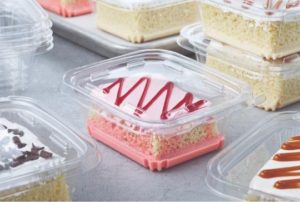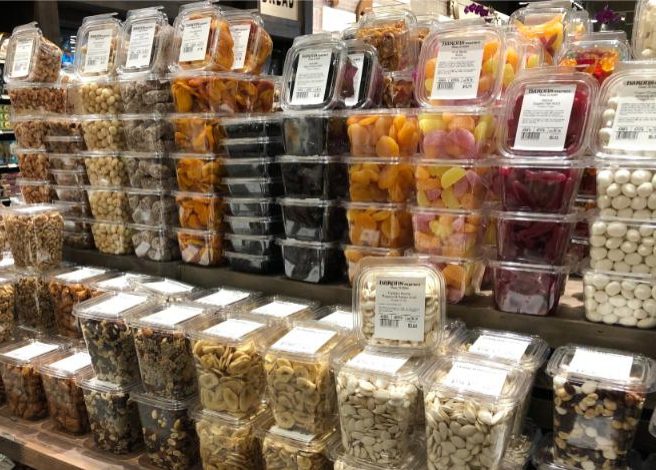Have you ever noticed how your supermarket snacks come in a transparent mini suitcase? There’s a fascinating world of engineering and economics behind those plastic containers we all take for granted. Plastic food packaging pricing might not be dinner party conversation material, but it’s a clever solution that keeps your food fresh.
If you’re a food industry professional, this cost goes into your bottom line and is an important factor when determining your profits. Do you know what costs go into the pricing of these containers? Could being armed with this knowledge give you an advantage over your competitors? What happens when you aren’t aware?
What Influences the Price of Plastic Containers?
 Here at Inline Plastics, we’ve identified food packaging cost factors. Today we’re happy to share what we’ve learned in over 50 years of experience so you can have a clear image of what goes into pricing of thermoformed plastic packaging.
Here at Inline Plastics, we’ve identified food packaging cost factors. Today we’re happy to share what we’ve learned in over 50 years of experience so you can have a clear image of what goes into pricing of thermoformed plastic packaging.
Let’s first define what a “thermoformed” plastic package is. Thermoformed plastic packages are containers made by heating large sheets of plastic and shaping them using pressure, vacuum, and mechanical assist into the desired product.
Raw Materials
The journey begins with the raw material choice — the most common clear materials are PET (polyethylene terephthalate), PP (polypropylene), or OPS (oriented polystyrene). We’ll just call them PET, PP, and OPS moving forward. Each material brings its own price point to the table, and to make things more complex, the raw materials for each are different and subject to unique fluctuations. In other words, what’s more expensive in one period may be cheaper the next.
The final price tag is influenced by many factors, including material choice, which impacts both cost and manufacturing. Plastics like PET, PP, OPS, and others are derived from raw materials like oil and natural gas. The prices of these products fluctuate with changes in these markets.
The Production Process
From the first spark of an idea to the moment a product reaches your hands, there’s an intricate dance of costs and processes at play. Research and development kicks things off, turning concepts into viable products through careful testing and refinement.
Then comes the heavy lifting: investing in specialized machinery, tooling, and equipment that will bring these ideas to life.
But that’s just the beginning. Day-to-day operations require constant attention—machines need maintenance, utilities keep running, and skilled workers provide the essential human touch at every stage.
Quality assurance teams meticulously inspect products, ensuring they meet rigorous industry standards. In the food industry, this is particularly crucial, as safety regulations protect consumers and maintain public trust.
The Product Itself

Picture two homes: a sprawling five-story mansion overlooking the ocean and a modest one-room cabin nestled in the forest. The choice of which costs more is obvious: —the mansion commands a premium price because of its size, location, and luxurious features.
This same principle applies perfectly to packaging solutions. Imagine two containers side by side: a basic plastic vessel with a simple snap-on lid and its premium counterpart engineered for peak performance.
The higher-end option represents an investment in product development. This package was likely created to achieve certain standards of quality and excellence while incorporating sophisticated materials.
Thoughtful design elements such as extending shelf life and providing superior leak protection are also commonly found in higher-quality containers.
This quality commands a higher price point as it delivers tangible value through enhanced durability and practical features safeguarding your product. Think of premium packaging as more than just an attractive exterior: it’s a vigilant guardian ensuring your product reaches consumers in perfect condition.
Sustainability
 As every industry continues to make efforts to improve sustainability and reduce its carbon footprint, it’s essential to know that this comes at a cost.
As every industry continues to make efforts to improve sustainability and reduce its carbon footprint, it’s essential to know that this comes at a cost.
Quite simply, sustainable products are generally more expensive to produce because of materials, manufacturing processes, maintaining quality standards, and certifications.
If a manufacturer uses a percentage of recycled material, that is factored into the price of the final product. It’s healthy to be skeptical of any company claiming to have a product made with a high percentage of recycled material, especially in the food packaging industry.
Global Events
It’s common knowledge that COVID affected nearly every industry worldwide, including food packaging. Whether by land or by sea, shipping costs increased. Shipping is just one example of how a global event can affect the market and raise the product’s price.
Geopolitical developments can influence international supply chains and pricing. For example, when importing oil from other countries, transportation logistics can be impacted by regional circumstances, such as inclement weather.
Oil, a key raw material for plastic production, can face supply disruptions when shipping routes from regions like the Middle East and Asia are blocked or ports are closed. Remember in 2021 when that one ship got stuck in the Suez Canal? The blockage halted an estimated $9.6 billion worth of trade each day. Over the six days, it was jammed, this amounted to nearly $60 billion dollars in trade disruption. This caused port closings, delayed shipments, and chaos in supply chains. Hopefully, nothing aboard those ships was perishable!
The Buying Process
The majority of customers order their products through a distributor. Working with a distributor is a valuable part of buying as they store, ship, and deliver the order. Distributors also may carry additional items you may need that the manufacturer may not produce, such as napkins, cups, and cutlery.
Distribution centers are located nationwide and worldwide, helping customers quickly get the product they need. You can expect to pay more for utilizing their services however the cost is often well worth it.
There are, however, unique, high-volume customers who may be able to order directly from the manufacturer. This is also referred as ‘going direct’ – direct to the manufacturer that is! This process bypasses intermediaries such as wholesalers or distributors. By avoiding these third parties, customers seem to be saving money.
Think of a direct sales approach like going to a farm to buy produce. You purchase the fruit directly from the source at a seemingly lower price, but are limited to what is available at that specific time and location. If you were to shop at a grocery store (which would be a distributor in this example), you could buy a much wider variety of items at a slightly higher price because they ship different products into their locations and store the products there.
How Much Does Each Plastic Food Package Cost?
Are you still wondering about specific pricing? Don’t worry. We wouldn’t have led you this far without giving you some kind of number. Let’s sum it up:
Thermoformed plastic food packaging typically costs between $0.10 and $1.30 per unit, with prices varying significantly based on several key factors. Packages at the lower end generally feature smaller sizes, simple designs, and basic materials produced in high volumes with minimal engineering requirements. Mid-range products offer medium-sized containers with improved features like enhanced sealing and durability. At the same time premium packages incorporate larger sizes, complex engineering solutions, sophisticated design elements, and advanced features. These features include extended shelf life and superior leak protection. The final price point is further influenced by distribution methods, order volume, geographic location, shipping requirements and market conditions affecting raw materials. Not to mention regulatory compliance, and any customization needs. This pricing structure remains dynamic and fluctuates with market conditions. Buyers must consider both immediate and long-term costs when selecting packaging solutions.
The Full Package: Plastic Food Packaging Pricing Conclusions
There is no simple answer to determining thermoformed packaging pricing. Contact your packaging supplier for current pricing options. Market conditions and material costs fluctuate regularly, so your supplier maintains the most up-to-date pricing information for your selected packaging solutions. They can provide detailed quotes reflecting current market rates, volume discounts, and any seasonal adjustments that may affect your packaging needs.
Finding the right fit for you is our priority, whether that’s Inline Plastics’ solutions or another option entirely. Questions? We’re always here to help.


